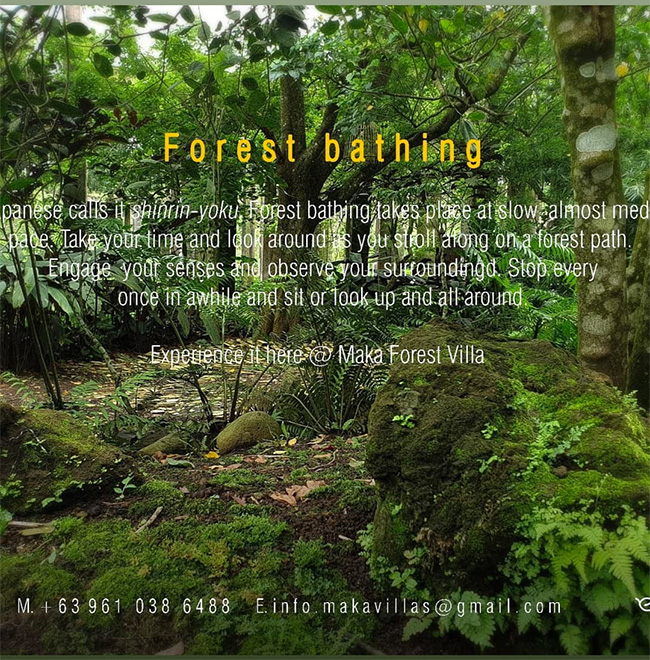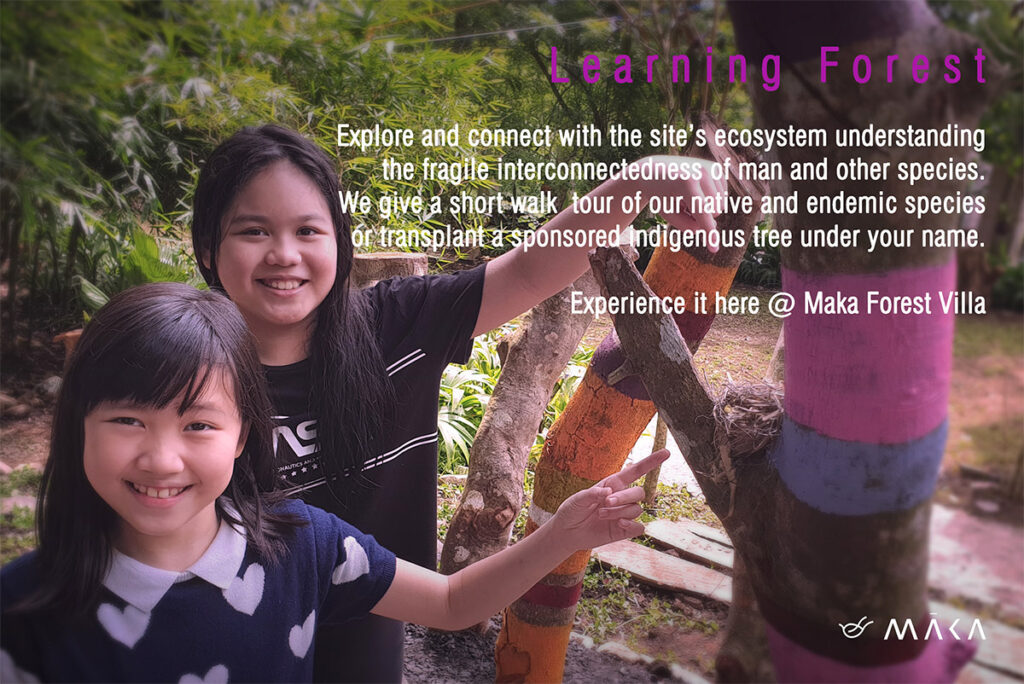
Bathe in the forest at Maka Forest Villa
We are all polluters. Unless we live totally off-grid like the foraging and hunting indigenous people, we will always be part of the problem. As the young, outspoken Swedish environmental activist Greta Thurnbeg has said, “Our house is on fire.”
Indeed Greta’s fiery speech, “How dare you” attracted world leaders, some of whom criticized her for oversimplifying a complex problem.
Even former American Vice-President Al Gore, who educated people on global warming through the documentary “An Inconvenient Truth,” was criticized for using more electricity at his home than the average American.
Reduce Carbon Footprint
Nobody’s perfect but we should try our best to reduce our carbon footprint. Greta, the youngest “Time Person of the Year,” advocated veganism, upcycling and giving up flying. In fact, she sailed from England to America on a yacht on her way to a mission in the U.S. Mainland.
With the inception of environmental consciousness came the buzzwords “sustainability” and “recycling.” The Philippine government reacted with the creation of the Department of Environment and Natural Resources. The private sector’s response ranged from “no plastics” policy in groceries to the creation of “smart” buildings and cities. The LEED (Leadership in Energy and Environmental Design), a green building certification program used worldwide, was developed in the United States and also used in the Philippines. It includes a set of rating systems for the design, construction, operation, and maintenance of green buildings, homes, and neighborhoods which aims to help building owners be environmentally responsible and use resources efficiently. (Wikipedia).
But what about the toxic components of solar panels and the degradation of wildlife habitat by wind turbines?
Sustainability is Not Enough
Jacob A. Littman of the University of Massachusetts Amherst, in his study “A Pathway Beyond Sustainability,” said “The current standard of building requires very little in regard to the environment and the standard that is set for what is considered a “sustainable” building is extremely low.” In other words, it just makes the building “less bad.”
Regenerative Architecture
A better alternative is regenerative architecture which was defined by Littman as the practice of engaging the natural world as the medium for and generator of architecture. It focuses on the reduction of environmental impact of a building and treats the environment as an equal shareholder in the architecture. Buildings co-exist as part of place not only aesthetically but also functionally. Regenerative architecture is the integration of the site, the building, the system, the energy, the flora and fauna.
Mud Homes
This kind of architecture reminds me of those fanciful fast-forward You Tube videos of people building a swimming pool in the middle of a jungle using resources from nature. Mud houses are still found in Africa. Outside the tribal and indigenous world, some sectors have built natural homes literally from the earth. They use sand, water, clay, straw, and other natural building materials.
Tiny Houses
Another trend is the Tiny House movement which encourages people to live in a compact place. It advocates downsizing living spaces, simplifying and essentially living with less. According to the 2018 International Residential Code, a tiny house is a dwelling unit with a maximum of 37 square meters of floor area excluding loft.
Natural homes and tiny houses may embrace some aspects of survivalism and minimalism but not entirely environmentalism, especially tiny houses which may use container vans or other non-renewable resources.
Back to the Woods
Because of the COVID-19 pandemic, many city dwellers returned to the ruralscape to breathe some fresh air on a wide open space. They learned to till the soil and plant for their sustenance.
Even before the pandemic, Architect Ronnie Yumang, together with his wife and daughter, decided to leave the chaotic, polluted, and noisy concrete jungle of Manila. They wanted to live in the “real world” with minimum modern conveniences. That paradigm shift was the start of an awakening.
In Cavite, he found an old poultry farm hidden in the bucolic, foggy and cool weather of Sulsugin with some rugged terrain leading to a creek. The moment he saw the land, his architectural cognition kicked in and had visions of what he would do with it.
Where Good Spirits Reside

There was an immediate spiritual connection as if the land was calling them. They started redesigning how they could live and adapt a locus-based living. They started practicing the ancient wisdom of how our indigenous people lived and merged it with suitable practical modernity. They called their home Maka Forest Villa. Maka means “where good spirits reside” in ancient Tagalog.
Eastern Garden
Walking around Maka is like wandering in a zen garden surrounded by trees. Ronnie has embraced Eastern learning because he believes Western learning is responsible for the earth’s degradation. He also believes in propagating native and endemic trees. There are meditation spots and even a place where you can walk barefoot and feel “grounded.” He even built a small pool based on his observations from nature. It is nature recreated.
Use Available Materials
There are many approaches to regenerative design. Foremost is the use of materials available on site. They use a specific soil called “buga,” the very pure white part of clay which they get from the top of the termite mound. Termite mounds are primarily composed of termite saliva, feces and clay. If the queen termite is not disturbed, the termites will keep producing the mound. The clay is then mixed with cement and compacted. This rammed earth construction, which is an ancient way of compacting soil, does not use steel. It is the same principle in building mud houses but with less clay.
Restore Biodiversity
Ronnie advocates preserving native and endemic trees such as dapdap, antipolo, kakawati, pili, kalumpit, and balayong. He also recommends planting endangered trees.
Adaptive Reuse of Existing Structures
The property they bought was an old poultry farm with structures. One part was transformed into a function hall. Another part will be converted into a “workation” facility. In both structures, the finish remained as is. Maka adheres to wabi-sabi which is natural beauty in imperfection, incompleteness and impermanence.
Upcycle Residual Materials
Even residual materials from construction such as rebars were upcycled into decorative table legs. A sink was made from recycled corsten steel.
Promote Local Craft and Renewable Materials
Maka uses tanlak reeds as sunscreen. They are cheap and easily replaced. Artisanal crafts such as solihiya are also used.
Learn from Nature

Nature was copied in making a Japanese onsen-inspired pond. A biofiltration system will use charcoal, sand, and pebbles. It will also be heated.
Provide Plenty of Space for Nature
Unlike the concrete jungle of Manila, Maka will only use 30 percent as a developmental area.
The remaining 70 percent is open space planted with native endemic trees where you will get your resources like food and wood.
We may all be polluters but living in a beautiful earthen home amid the trees will enable us to live, work, and play in a genuinely healthy community and be regenerators of nature.
As Thomas Fuller has said, “He that plants trees loves others besides himself.” Let us live with nature and nature will love us back.
Article and Photo originally posted by Property Report Ph last August 20, 2021 and written by JP Ordona.








More Stories
PHL to attract int’l real estate investors, occupiers — Cushman & Wakefield
Expansions, upgrades fuel Manila office market
Maximizing your investment: Aboitiz Land is ready for you